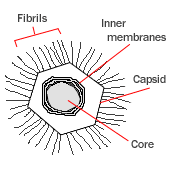11.21 病毒特征 - 高级
章节大纲
-
What must a do to "stay alive?"
::要怎么才能"活着"呢?First, remember that by today's definition, it is debatable if viruses are actually alive. In order to make more viruses, viruses must invade a host . Above is a depiction an alien-looking virus infecting a bacterial cell. A virus that infects is known as a bacteriophage .
::首先,请记住,根据今天的定义,病毒是否真的活着是值得商榷的。为了制造更多的病毒,病毒必须侵入宿主。此外,还要描述一种外星病毒感染细菌细胞。一种感染病毒的病毒被称为细菌。Characteristics of Viruses
::病毒特征A virus is a sub-microscopic particle that can infect living cells. Viruses are much smaller than , ranging in size from about 20–300 nanometers (nm), though some can be larger. Prokaryotes are typically 0.5–5.0 micrometres (µm) in length. As an example, if a virus were about the size of three soccer balls lying side-by-side, then a prokaryote would be about the size of soccer field.
::一种病毒是一种能感染活细胞的亚微微粒子。 病毒小得多,大小在20-300纳米左右,尽管有些可能更大。 丙烯酰胺的长度一般为0.5-5.0微米(微米 ) 。 举例来说,如果一种病毒的大小与相邻的三颗足球的大小相近,那么一种丙烯酸盐的大小就会与足球场的大小相近。Mimivirus, shown in Figure , is the largest known virus, with a diameter of 400 nm. filaments measuring 100 nm stick out from the surface of the virus, which increases the diameter of the virus to about 600 nm. This is bigger than a small bacterial cell. The virus appears hexagonal under an electron ; the viral shape is icosahedral (having 20 faces or sides).
::如图所示,米米病毒是已知的最大病毒,直径400纳米,直径为100纳米的丝丝从病毒表面伸出来,使病毒直径增加至约600纳米。这比一个小细菌细胞大。病毒在电子下出现六角;病毒形状为象形(面或侧面为20个)。The study of viruses is known as virology and people who study viruses are known as virologists . Viruses cause several serious human diseases, such as AIDS, influenza , and rabies. Therapy is sometimes difficult for . Antibiotics have no effect on viruses, and only a few antiviral drugs are available for some diseases. One of the best ways to prevent viral diseases is with vaccines , which produce . But vaccines are available for only a few diseases.
::病毒研究被称为病毒学,研究病毒的人被称为病毒学家,病毒导致几种严重的人类疾病,如艾滋病、流感和狂犬病。治疗有时很困难。抗生素对病毒没有影响,只有少数抗病毒药物可用于某些疾病。预防病毒疾病的最佳方法之一是疫苗,疫苗生产。但疫苗只能用于少数疾病。The largest known virus, called mimivirus, is so large that scientists first mistook it for a bacterium. It was first discovered in amoebae in 1992, and was identified as a virus in 2003. Scientists believe that mimivirus may cause certain types of pneumonia in humans. The core contains DNA, with the majority of the DNA in genes, and only 10% DNA of unknown function ("junk" DNA). Replication
::复制复制Viruses can replicate only by infecting a host cell. They cannot reproduce on their own. Viruses are not cells; they are a strand of genetic material within a protective protein coat called a capsid (see Viruses: Structure (Advanced) ). They infect a wide variety of organisms , including both eukaryotes and prokaryotes. Once inside the cell, they use the cell’s ATP , , , and other cellular structures to replicate. First, the host cell replicates the viral genome , then it transcribes and translates the viral genes , producing the structural components to package the viral genome and create new viruses.
::病毒只能通过感染宿主细胞复制才能复制。 病毒不是细胞; 病毒不是细胞; 病毒是保护性蛋白外皮内称为封盖的基因材料( 见病毒: 结构( 高级 ) ) 。 它们感染了各种各样的生物, 包括eukaryotes 和 prokaryotes 。 一旦进入细胞, 它们就会使用细胞的ATP, 和其他细胞结构复制。 首先,宿主细胞复制病毒基因组, 然后它转录并翻译病毒基因, 生成病毒基因组的结构元件来包装病毒基因组, 并创造新的病毒。Habitats
::生境和生境Viruses can be found almost anywhere there is life, including within prokaryotes. A phage is a virus that infects prokaryotes. Phages are estimated to be the most widely distributed and diverse entities in the , even more numerous than prokaryotic organisms. Phages can be found everywhere their hosts are found, such as in soil , in the intestines of , or in seawater. Up to 10 9 virions (a complete virus particle) have been found in a milliliter of seawater, and up to 70 percent of bacteria may be infected by phages. They are also found in drinking and in some foods, including fermented vegetables and meats, where they control the growth of bacteria.
::几乎在任何地方都能找到病毒,包括种虫内的病毒。一种病毒是感染种虫的病毒。据估计,在这种病毒中,光谱是分布最广泛和种类最多的生物体,甚至比蛋白质生物还多。其主食处都能找到光谱,如土壤、肠子或海水。在一毫升的海水中发现了多达109种病毒(一种完整的病毒粒子),70%的细菌可能受到phage的感染。它们还存在于饮用水和一些食物中,包括发酵蔬菜和肉类,它们控制着细菌的生长。Review
::回顾-
Distinguish between a virus and a phage.
::区分一种病毒和一种phage。 -
In general terms, how do viruses replicate? Could this be considered a type of asexual reproduction?
::一般而言,病毒是如何复制的?这可以被视为一种性生殖吗? -
What is one way to prevent viral diseases?
::预防病毒性疾病的方法是什么?
-
Distinguish between a virus and a phage.

